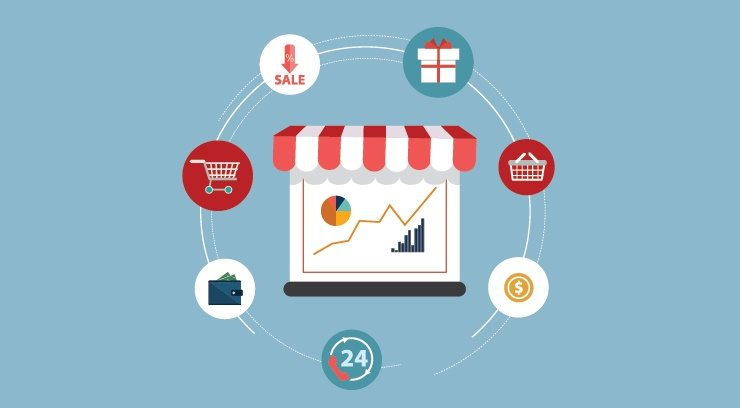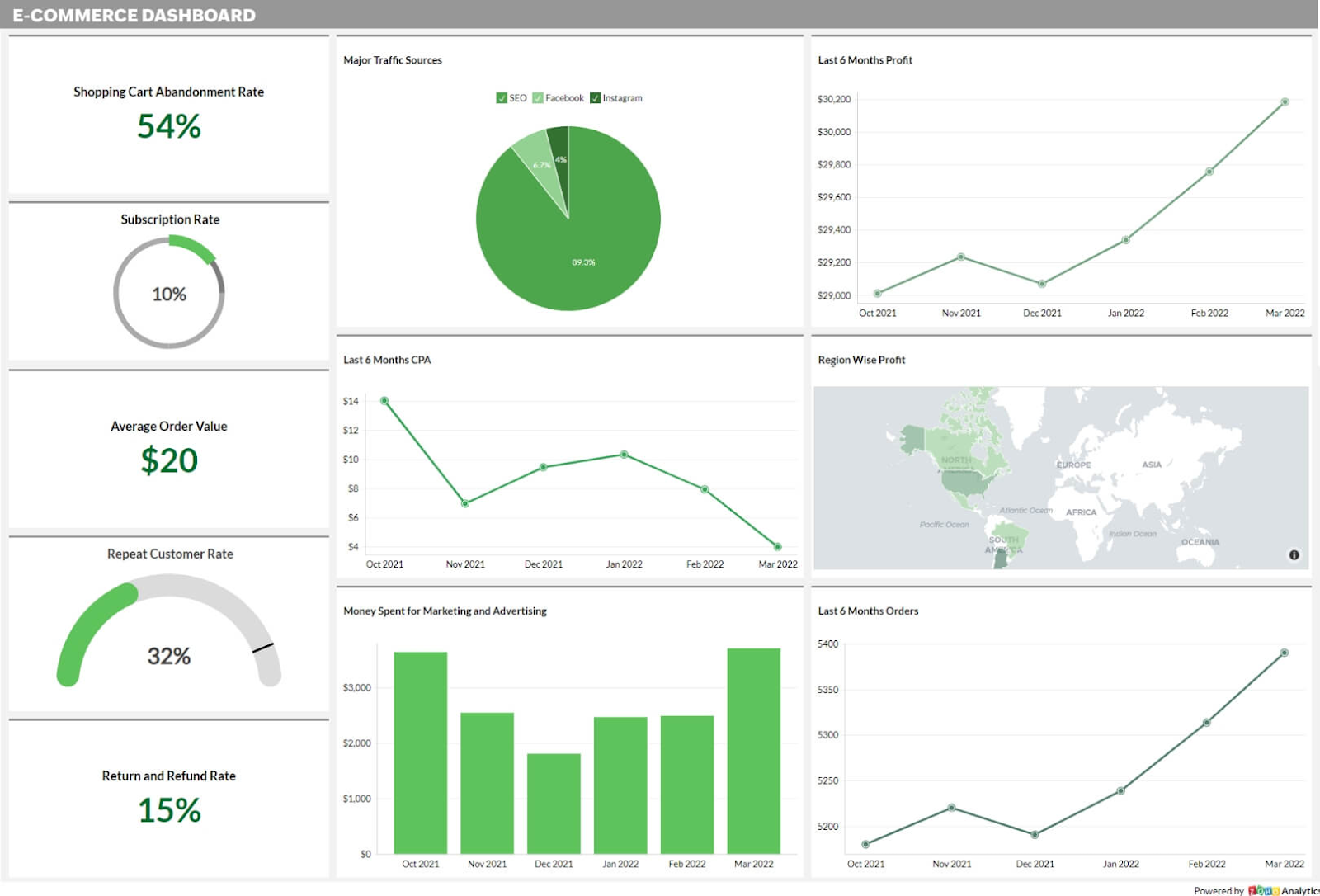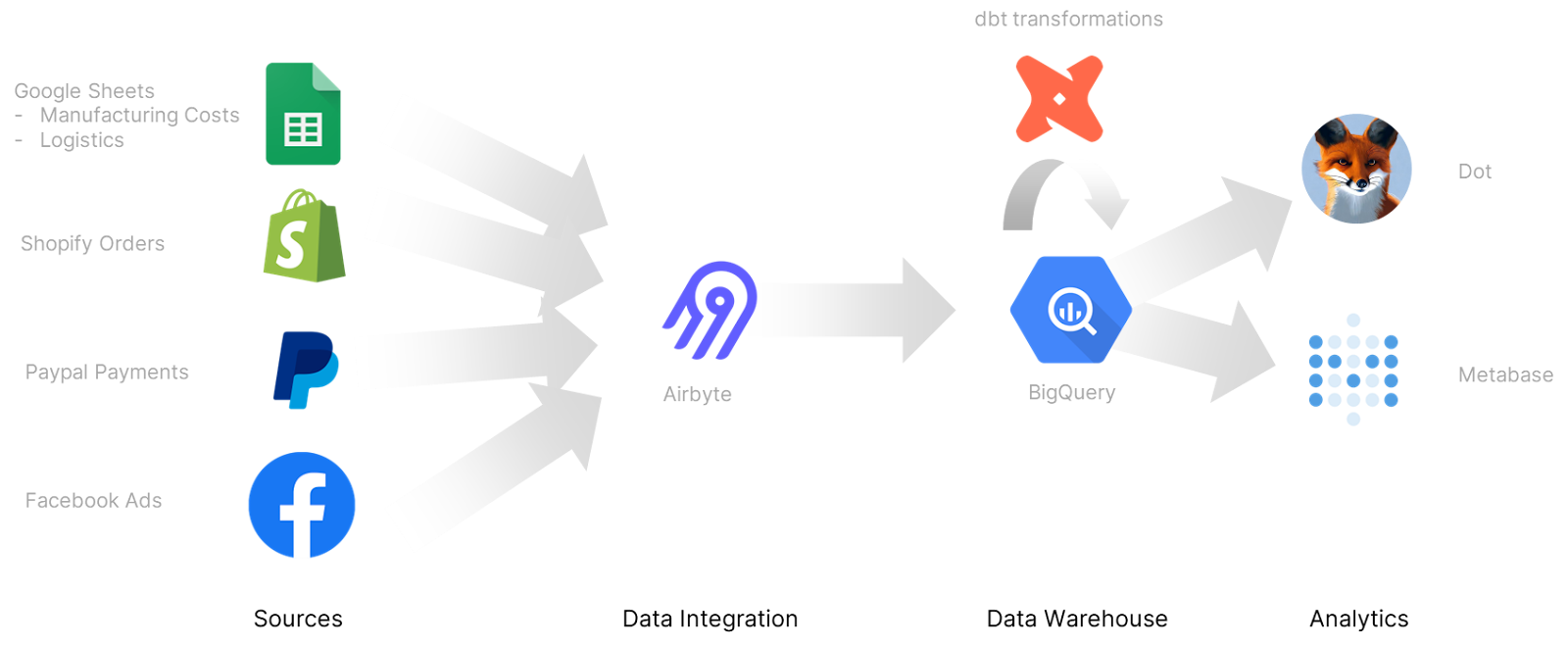Ecommerce Analytics: How to Analyze Data & Extract Insights
Summarize this article with:
✨ AI Generated Summary
The e-commerce industry demands real-time, AI-driven analytics to stay competitive by enabling immediate personalization, predictive modeling, and operational optimization. Key challenges include data integration, quality, privacy compliance, and handling large data volumes, which tools like Airbyte help address through automated, real-time data pipelines. Essential metrics span sales, marketing, customer behavior, and website performance, while advanced techniques like predictive, prescriptive, and sentiment analysis drive actionable insights for enhanced customer experiences and business efficiency.
The e-commerce industry continues to grow at remarkable rates, catering to varying consumer needs and preferences. Modern businesses are discovering that traditional batch analytics approaches are insufficient for today's fast-paced digital marketplace. When customers abandon carts or browse products, waiting hours or days for insights means missing critical opportunities to re-engage and convert.
E-commerce businesses must constantly analyze data to extract actionable insights and stay competitive. From understanding customer behavior in real-time to optimizing operations through predictive models, ecommerce analysis has evolved far beyond simple sales reporting. Today's leading retailers leverage advanced analytics techniques, including event-driven architectures, AI-powered personalization, and privacy-first data strategies, to create competitive advantages.
Let's explore the comprehensive landscape of e-commerce data analytics, examining both foundational concepts and cutting-edge methodologies that drive modern retail success.
What Is E-commerce Analytics and Why Does It Matter?

E-commerce analytics is the collection, analysis, and interpretation of data from online stores to make informed business decisions. It involves tracking metrics including sales, marketing, customer behavior, website traffic, and key performance indicators (KPIs).
With the gathered metrics, you can gain insights into your store's performance and identify areas for improvement. This leads to data-driven decisions that optimize online sales and marketing efforts. Modern ecommerce analysis extends beyond traditional reporting to include real-time behavioral tracking, predictive customer modeling, and automated optimization based on continuous data streams.
The evolution toward real-time ecommerce analysis has transformed how businesses respond to customer behavior. Instead of analyzing yesterday's data to influence tomorrow's decisions, leading retailers now capture customer interactions as they happen, enabling immediate personalization and intervention strategies.
How Important Is Data Analytics for E-commerce Success?
Data analytics in e-commerce helps you understand trends and patterns so you can make better decisions and become more agile and customer-centric. With comprehensive ecommerce analysis, you can:
- Optimize pricing and inventory performance through predictive demand modeling
- Discover trends for accurate forecasting using machine learning algorithms
- Measure the effectiveness of your marketing campaigns across multiple touchpoints
- Gain improved insights into customer behavior and preferences through advanced segmentation
- Use data-driven insights to enhance marketing strategies with personalized recommendations
- Refine the user experience of your online store based on behavioral analytics
- Enhance customer retention and loyalty through predictive churn modeling
These capabilities enable you to maintain a competitive advantage by swiftly adapting to market changes. Modern ecommerce analysis also empowers businesses to implement dynamic pricing strategies, predict inventory needs with greater accuracy, and create highly personalized customer experiences that drive engagement and conversion.
The strategic value of analytics extends to operational efficiency, where data-driven insights optimize everything from supply chain management to customer service resource allocation, creating sustainable competitive advantages in increasingly crowded markets.
What Are the Main Challenges With E-commerce Analytics?
E-commerce businesses encounter several significant challenges when implementing comprehensive data analysis strategies:
- Data Quality and Consistency: Issues such as incomplete, incorrect, or outdated information can compromise analysis and insights. Inconsistent data formats across different systems create additional complexity when attempting to build unified customer profiles or accurate performance metrics.
- Varied Data Sources and Integration Complexity: Data comes from numerous sources, including Google Ads, Facebook Ads, email marketing platforms, inventory systems, and customer service tools, making consolidation difficult. Each source may use different data schemas, update frequencies, and access methods, creating integration bottlenecks.
- Data Privacy and Security Compliance: Compliance with regulations like GDPR, CCPA, and emerging privacy laws requires sophisticated data governance frameworks. Balancing analytical insights with customer privacy protection demands careful implementation of data anonymization and consent management systems.
- Overwhelming Data Volumes: Large datasets can overwhelm smaller businesses with limited technical resources and infrastructure. Processing terabytes of customer interaction data, transaction records, and behavioral signals requires significant computational resources and expertise.
- Manual Integration Overhead: Manually integrating data from CRMs, social media platforms, and email marketing tools consumes valuable time and introduces error risks. Traditional approaches often create bottlenecks that delay critical business insights.
- Real-Time Processing Requirements: Modern ecommerce demands immediate insights for personalization, fraud detection, and inventory management. Legacy batch processing systems cannot support the real-time analytics needed for competitive advantage.
Tools like Airbyte address these integration challenges by automating data integration processes, providing over 600 pre-built connectors, and centralizing information from diverse sources into unified data repositories.
What Are the Essential E-commerce Analytics Metrics You Should Track?

Tracking the right metrics is critical for optimizing performance and driving sales. Modern ecommerce analysis requires comprehensive monitoring across multiple dimensions of business performance.
Sales Performance Indicators
- Average Order Value (AOV): Average spend per purchase, essential for understanding customer value and pricing optimization opportunities.
- Total Sales Revenue: Includes gross and net sales for a complete performance picture, segmented by product categories, customer segments, and time periods.
- Cart Abandonment Rate: Percentage of visitors who add items to a cart but don't complete a purchase, indicating potential optimization opportunities in checkout flow or pricing strategy.
- Sales Conversion Rate: Percentage of visitors who complete a purchase, fundamental for measuring the effectiveness of your sales funnel and user experience optimization efforts.
Marketing Campaign Effectiveness
- Click-Through Rate (CTR): Share of viewers who click a link or advertisement, indicating content relevance and audience engagement quality.
- Website Traffic Analysis: Number of visitors and their sources, including organic search, paid advertising, social media, and direct traffic patterns.
- Return on Advertising Spend (ROAS): Revenue generated per advertising dollar invested, critical for optimizing marketing budget allocation across channels.
- Impression and Reach Metrics: Number of times advertisements or content pieces are displayed, providing visibility into brand awareness and campaign reach effectiveness.
Customer Relationship Metrics
- Customer Lifetime Value (CLV): Projected revenue from a customer over their entire relationship with your business, essential for customer acquisition cost justification and retention investment prioritization.
- Customer Acquisition Cost (CAC): Average cost to acquire a new customer across all marketing channels, fundamental for evaluating marketing efficiency and profitability.
- Net Promoter Score (NPS): Likelihood of customers recommending your business to others, indicating customer satisfaction and potential for organic growth through referrals.
- Customer Retention Rate: Percentage of customers who remain active over specific time periods, directly correlating with long-term business sustainability and profitability.
Website Performance and User Experience
- Page Load Time: Website speed performance, as faster pages improve user experience and reduce bounce rates while positively impacting search engine rankings.
- Time on Site: Average session duration indicating user engagement levels, with higher times typically suggesting content relevance and user interest.
- Returning Visitor Percentage: Repeat traffic that signals customer loyalty and brand affinity, indicating successful customer experience and value delivery.
- Pages Per Visit: Average pages viewed in one session, reflecting user engagement depth and content effectiveness in driving exploration.
What Types of E-commerce Data Analysis Techniques Should You Use?
Different analytical techniques address specific business objectives and provide various levels of insight depth. Modern ecommerce analysis combines multiple approaches for a comprehensive understanding.
- Descriptive Analysis: Summarizes past performance including traffic patterns, revenue trends, and customer demographics to identify historical patterns and baseline performance metrics. This foundational technique provides context for more advanced analytical approaches.
- Predictive Analysis: Uses historical data and machine learning algorithms to forecast future customer behavior, demand patterns, and customer lifetime value. Advanced predictive models enable proactive inventory management and personalized marketing campaign optimization.
- Prescriptive Analysis: Recommends specific actions to minimize costs or maximize revenue based on data-driven optimization models. This technique provides actionable guidance for pricing strategies, inventory allocation, and marketing budget distribution.
- Sentiment Analysis: Extracts customer sentiment and emotional indicators from reviews, social media posts, and customer service interactions. Natural language processing techniques provide insights into brand perception and product satisfaction levels.
- Churn Analysis: Identifies customers likely to discontinue purchases, enabling targeted retention campaigns and proactive customer success interventions. Predictive churn models help prioritize retention efforts and optimize customer lifecycle management.
- Cohort Analysis: Tracks customer groups over time to understand behavior patterns, retention trends, and value evolution. This technique reveals insights about customer journey optimization and long-term business performance drivers.
How Do You Perform Comprehensive E-commerce Data Analytics?
Effective ecommerce analysis requires systematic approaches that ensure data quality, integration efficiency, and actionable insights generation.
1. Data Collection and Source Integration
Gather comprehensive data on product performance, website traffic, customer purchase histories, and interaction patterns across all touchpoints. Modern collection strategies include real-time event tracking, API integrations, and automated data pipelines that capture customer behavior as it occurs.
2. Data Quality Management and Cleaning
Correct errors, remove duplicates, handle missing values, and standardize data formats across different sources. Implement automated data validation rules and monitoring systems to maintain ongoing data quality standards.
3. Centralized Data Integration and Warehousing
Combine data from multiple sources into centralized repositories such as cloud data warehouses or data lakes. This consolidation enables comprehensive analysis across customer touchpoints and business functions.

Airbyte offers over 600 configurable connectors and no-code/low-code integration options, including a Connector Development Kit, to automate e-commerce data integration. The platform's change data capture capabilities ensure real-time synchronization between operational systems and analytical databases.
4. Advanced Analytics Implementation
Apply sophisticated analytical tools, including Power BI, Tableau, Looker, and specialized ecommerce analytics platforms, to visualize trends, generate insights, and create actionable dashboards. Implement machine learning models for predictive analytics and automated optimization recommendations.
What Are the Best E-commerce Analytics Tools Available?
Modern ecommerce analysis requires tools that can handle diverse data sources, provide real-time insights, and support advanced analytical techniques.
- Google Analytics 4: Comprehensive free platform with enhanced e-commerce tracking, cross-platform measurement, and machine learning-powered insights. Provides advanced segmentation capabilities and predictive metrics for customer behavior analysis.
- Kissmetrics: Customer-centric analytics platform offering detailed behavioral tracking, funnel analysis, and cohort reporting. Specializes in individual customer journey mapping and lifetime value optimization.
- Hotjar: User experience analytics platform providing heat-mapping, session recordings, and user feedback collection. Essential for understanding customer behavior patterns and identifying optimization opportunities in website design and functionality.
- Optimizely: Experimentation and personalization platform enabling A/B testing, multivariate testing, and dynamic content optimization. Supports data-driven decision making through controlled experimentation and statistical analysis.
- Glew: Multichannel e-commerce analytics platform designed for businesses with extensive marketing footprints across multiple channels. Provides unified reporting and attribution modeling for complex marketing ecosystems.
- Mixpanel: Event-based analytics platform specializing in user behavior tracking and conversion funnel analysis. Offers advanced segmentation and retention analysis capabilities with generous free tier options.
- Woopra: Real-time customer journey analytics platform focused on reducing abandonment and optimizing conversion paths. Provides comprehensive customer profiles and automated engagement triggers.
How Can Real-Time Analytics and Event-Driven Architecture Transform Your E-commerce Analysis?
Real-time analytics capabilities have revolutionized how e-commerce businesses respond to customer behavior and market conditions. Event-driven architectures enable immediate processing of customer interactions, inventory changes, and transaction data, creating opportunities for instant personalization and optimization.
Implementing Event-Driven Data Processing
Event-driven architectures capture customer actions such as product views, cart additions, and purchase completions as discrete events that trigger immediate analytical processing. This approach enables real-time inventory updates, dynamic pricing adjustments, and instant personalization based on current customer behavior patterns.
Modern e-commerce platforms leverage streaming data pipelines to process events continuously rather than in scheduled batches. Tools like Apache Kafka and Apache Flink work alongside platforms like Airbyte to create seamless data flows from operational systems to analytical databases, ensuring insights remain current and actionable.
Benefits of Real-Time Customer Insights
Real-time analytics enable immediate response to customer behavior patterns, allowing businesses to intervene during critical moments in the customer journey. When customers abandon carts, real-time systems can trigger immediate email campaigns or display targeted offers to encourage completion.
Dynamic inventory management becomes possible when real-time data streams provide instant visibility into stock levels, demand patterns, and supply chain conditions. This capability prevents overselling, enables automatic reordering, and supports dynamic pricing based on current market conditions.
Infrastructure Requirements for Real-Time Processing
Implementing real-time ecommerce analysis requires robust data infrastructure capable of handling high-volume, low-latency data streams. Cloud-native architectures using services like AWS Kinesis, Google Cloud Pub/Sub, or Azure Event Hubs provide the scalability needed for growing e-commerce operations.
Integration platforms like Airbyte support real-time data synchronization through change data capture capabilities, ensuring that analytical systems receive immediate updates when operational data changes. This creates the foundation for responsive, data-driven decision-making across all business functions.
What Role Does AI-Driven Predictive Analytics Play in Modern E-commerce Analysis?
Artificial intelligence and machine learning have transformed ecommerce analysis from reactive reporting to proactive optimization. AI-driven predictive analytics anticipate customer behavior, optimize operations, and personalize experiences at unprecedented scale and accuracy.
Predictive Customer Behavior Modeling
Machine learning algorithms analyze historical customer data to predict future actions including purchase likelihood, product preferences, and optimal engagement timing. These predictions enable proactive marketing campaigns, personalized product recommendations, and dynamic content optimization that drives conversion rates significantly higher than generic approaches.
Advanced segmentation techniques use clustering algorithms to identify customer groups with similar behaviors and preferences, enabling targeted marketing strategies and personalized user experiences. Predictive models can forecast customer lifetime value, churn probability, and optimal acquisition channels for different customer segments.
Dynamic Pricing and Inventory Optimization
AI-powered pricing algorithms analyze competitor pricing, demand patterns, inventory levels, and customer behavior to optimize prices in real-time. These systems balance profit maximization with competitive positioning while considering factors like customer price sensitivity and market conditions.
Predictive inventory management uses machine learning to forecast demand across products, seasons, and customer segments. These systems optimize stock levels, reduce carrying costs, and minimize stockouts by anticipating demand fluctuations before they impact sales performance.
Personalization and Recommendation Engines
Modern recommendation systems leverage deep learning techniques to analyze customer preferences, browsing behavior, and purchase history to deliver highly relevant product suggestions. These systems continuously learn from customer interactions to improve recommendation accuracy and drive higher conversion rates.
Personalization extends beyond product recommendations to include dynamic website content, email marketing optimization, and customized user interface elements. AI algorithms determine optimal content presentation, promotional offers, and engagement strategies for individual customers based on their unique preferences and behavior patterns.
Implementation Considerations for AI Analytics
Implementing AI-driven ecommerce analysis requires high-quality data, appropriate infrastructure, and ongoing model management. Data integration platforms like Airbyte provide the foundation by ensuring AI systems have access to clean, comprehensive, and real-time data from all relevant sources.
Organizations must also consider privacy implications when implementing AI analytics, ensuring compliance with data protection regulations while maximizing analytical insights. Privacy-preserving techniques like differential privacy and federated learning enable powerful analytics while protecting customer information.
Conclusion
E-commerce analytics has evolved from simple sales reporting to a sophisticated ecosystem of real-time insights, AI-driven predictions, and event-based architectures. Successful retailers now combine multiple analytical approaches—from descriptive to predictive and prescriptive—to optimize every aspect of their operations.
Implementation requires robust data integration, quality management, and the right mix of specialized tools to address unique business challenges. With proper implementation, e-commerce analytics transforms raw data into actionable intelligence that drives competitive advantage through personalized customer experiences and optimized operations.
Frequently Asked Questions
What is the difference between e-commerce analytics and e-commerce analysis?
E-commerce analytics refers to the tools, systems, and processes used to collect and measure data, while e-commerce analysis involves the interpretation and examination of that data to derive actionable insights for business decision-making.
How often should I review my e-commerce analytics data?
Review frequency depends on your business needs and data complexity. Key metrics should be monitored daily, comprehensive performance reviews weekly, and strategic analysis monthly. Real-time monitoring is essential for critical metrics like inventory levels and conversion rates.
What is the most important metric for e-commerce businesses to track?
While all metrics provide value, Customer Lifetime Value (CLV) is often considered most critical as it encompasses customer acquisition costs, retention rates, and revenue potential, providing a comprehensive view of customer relationships and business sustainability.
How can small e-commerce businesses implement advanced analytics without large budgets?
Start with free tools like Google Analytics 4, focus on the most impactful metrics for your business model, and gradually implement more sophisticated analysis as your business grows. Cloud-based analytics platforms often offer scalable pricing models suitable for growing businesses.
What data privacy considerations should I keep in mind when implementing e-commerce analytics?
Ensure compliance with regulations like GDPR and CCPA by implementing proper consent mechanisms, data anonymization techniques, and secure data storage practices. Be transparent about data collection and provide customers with control over their personal information.

.webp)
